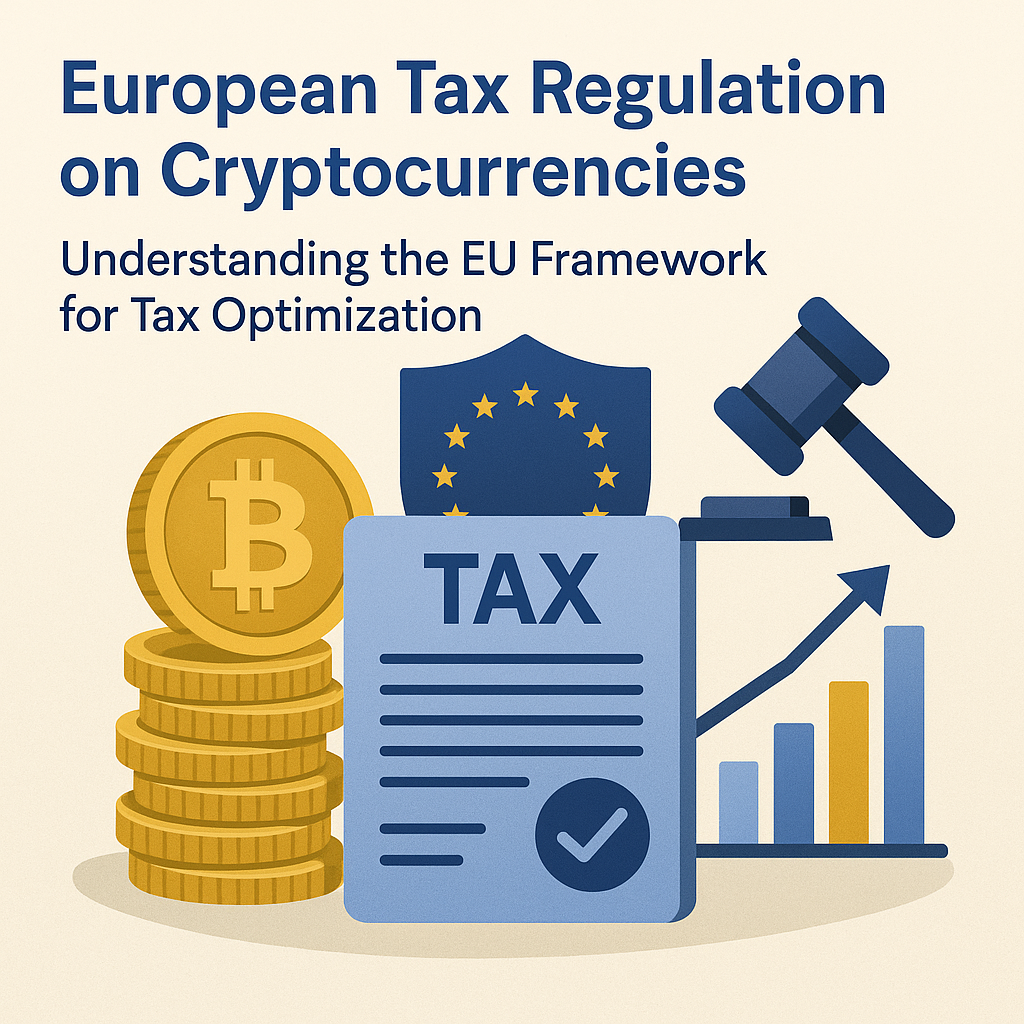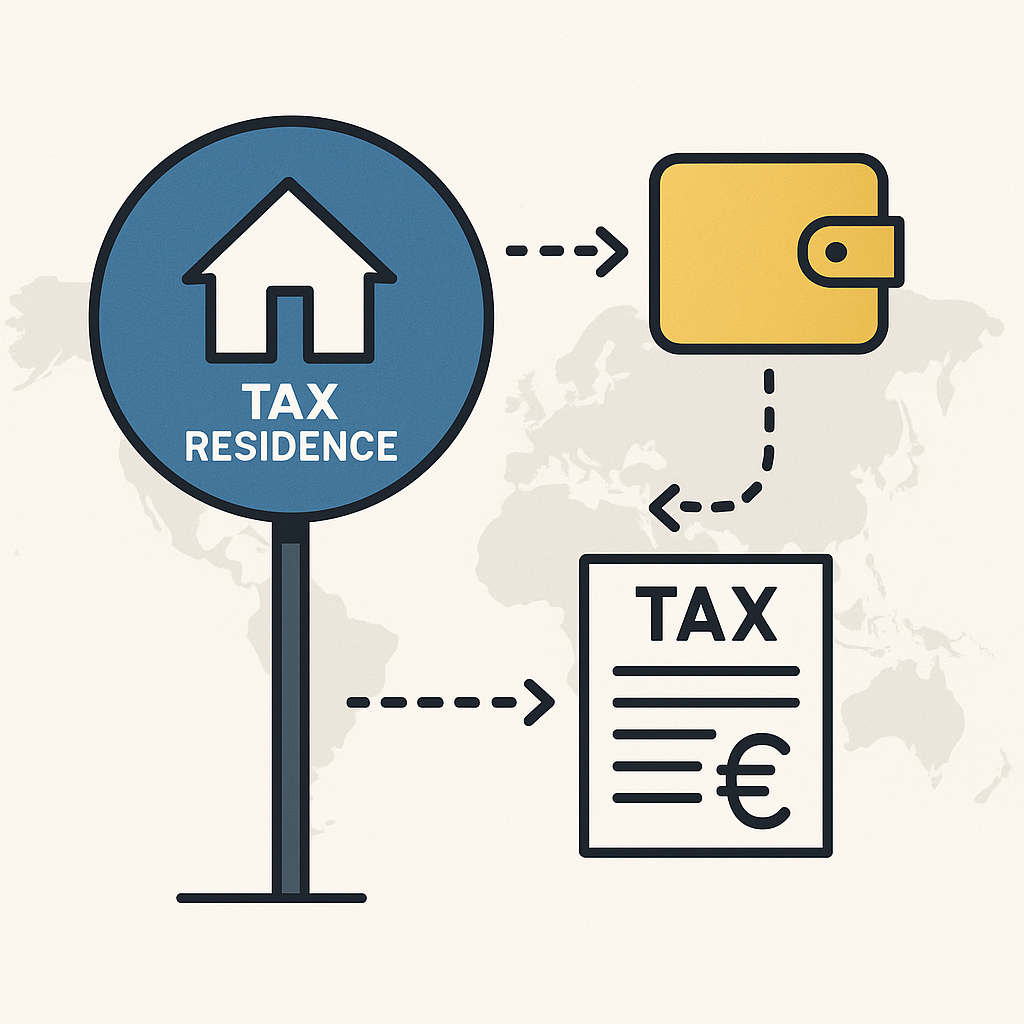
The regulation of the cryptocurrencies market in the European Union (EU) is evolving rapidly. The rise of digital assets has driven legislators and fiscal authorities to establish clearer rules on crypto activities. Both regulatory and tax frameworks are being reshaped to balance market development with more transparency, ensuring that every transaction is properly reported and that capital gains are fairly taxed. Although tax rules still differ among Member States, a more coherent environment is emerging. Today, the European Union is progressing towards a harmonized regulatory structure through initiatives such as the Markets in Crypto-Assets Regulation (MiCA) and DAC8. This article offers an overview of European cryptocurrency taxation, the evolving legislative landscape, tax rate disparities, reporting requirements, and strategies for compliant tax optimization.
Crypto-asset Regulation in Europe: The Path Toward Harmonization
Historically, each European country interpreted digital assets differently. Some nations categorized cryptocurrencies as financial assets, others treated them as properties or intangible assets, while a few initially exempted private investors from taxation.
The first major step toward continental harmonization came with the Markets in Crypto-Assets Regulation (MiCA), which establishes rules for crypto-asset service providers such as exchanges, brokers, and wallet operators. MiCA aims to bring clarity to how tokens should be handled, promote market stability, and boost investor confidence. Under MiCA, all service providers must obtain authorization, maintain transparent governance, adhere to operational and prudential standards, and ensure investor protection. By standardizing definitions and obligations, MiCA provides the EU with a coherent foundation for regulating the cryptocurrencies market and ensures that all participants operate under clear and consistent rules.
Alongside MiCA, the EU introduced the Directive on Administrative Cooperation 8 (DAC8), designed to enhance transparency and prevent tax evasion within the Member States. DAC8 requires automatic information exchange among tax administrations, enabling them to track transactions, identify undeclared earnings and enforce compliance. Wallets, exchanges, and brokers will be required to collect, verify, and report data on their clients’ transactions and tax residences to national tax authorities. Starting from January 2026, these entities known as Reporting Crypto-Asset Service Providers (RCASPs) will be obligated to submit their first reports, marking a significant step toward EU-wide fiscal transparency. This system mirrors the Common Reporting Standard (CRS) used for traditional banking, marking the end of anonymity in crypto taxation. Combined, MiCA for regulation and DAC8 for fiscal transparency push Europe toward an integrated framework that bridges regulatory and fiscal dimensions of the digital economy. This integration reduces the anonymity traditionally associated with wallets and exchanges, making undeclared earnings increasingly difficult to conceal.

Understanding Tax Residence and Capital Gains in EU Crypto Taxation
A fundamental rule in European crypto taxation relates to determine the correct tax residence. For most individuals, tax residence is defined by factors such as permanent home location, time spent in a country, economic interests and family ties. Residency determines the applicable tax rate, declaration forms, and whether tax advantages exist for certain holding periods or investment practices. Even when tokens are stored in a wallet located abroad or traded through a foreign exchange or broker, taxation is still determined by the residence of the asset owner. The location of the transaction, the exchange, or the intermediary does not override national taxation rights if the taxpayer resides in an EU Member State. As the cryptocurrencies market becomes borderless, tax residence rules prevent individuals from escaping taxes simply by choosing foreign platforms. However, relocating to a different EU country or outside Europe can change tax obligations entirely, highlighting the importance of understanding residency if considering international mobility for crypto tax optimization.
Most EU countries treat crypto as a taxable financial asset, meaning profits may be classified as capital gain. It typically occurs when converting crypto to FIAT currency, exchanging one token for another, or using digital assets to purchase goods or services. Notable exceptions exist—for example, France does not tax token-to-token exchanges for occasional investors; taxation arises on conversion to FIAT or spending. While tax approaches share similarities, rates and specific rules vary significantly. France has a 30% flat tax on digital assets, Germany exempts private investors from capital gains if the assets are held for more than 12 months and Portugal shifted from a tax-free regime to a structured taxation model and now levies a 28 % flat tax on short-term disposals while exempting long-term holdings. Some systems use progressive income tax brackets; others rely on flat rates or special schemes for new residents and foreign investors.
In addition, activities such as staking, liquidity providing, yield farming, and mining are often taxed as recurring income when rewards are received. These may generate recurring taxable income, taxable at ordinary income rates rather than as capital gain. The calculation of a capital gain from a crypto-asset is based on the difference between its acquisition price and its sale or disposal price. A positive result represents taxable earnings. When classified as a financial asset, the gain falls under capital gains taxation, with the applicable tax rate varying by Member State. In France, for example, the flat 30 % tax applies to occasional investors. Professional traders, however, are subject to income tax under business profit categories, with rates reaching up to 45 %. If crypto activity reaches a professional level, profits can be reclassified as business income rather than private investment returns. This reclassification entails stricter accounting duties, possible social-security contributions, and different tax schedules. Criteria vary by jurisdiction but commonly consider turnover, frequency, leverage, and intent. Some jurisdictions provide tax advantages such as exemptions for token-to-token exchanges, lower rates for long-term holdings, or thresholds below which taxation is not applied.
Nevertheless, these advantages are gradually narrowing as harmonization progresses. Preferential treatments — such as long-term exemptions, token-to-token deferral, or threshold reliefs — are narrowing as the EU aligns taxation with financial regulation under MiCA and DAC8. Over time, crypto-assets are being treated more like traditional investments in shares and bonds, with converging compliance and reporting standards. Europe classifies cryptocurrencies differently depending on its use. When used as investment holdings, crypto is treated as a financial asset. When functioning as a payment instrument, it may fall into a separate category, though VAT (value-added tax) does not apply to crypto exchange activities due to earlier rulings by the Court of Justice of the European Union. New forms of tokens, such as utility tokens and asset-backed tokens, require careful analysis to determine VAT exposure.

Tax Advantages and Legal Tax Optimization in Europe
Despite increasing oversight, Europe offers various legitimate paths for tax optimization on crypto. Strategies may include holding assets for periods that qualify for reduced tax rate or exemptions, choosing countries with favorable tax rules when establishing personal or business tax residence, or investing in legally-recognized digital asset structures. Some EU states provide tax advantages to innovative blockchain projects, digital finance firms, and long-term savers. Some EU Member States grant tax advantages to blockchain start-ups, fintech projects, and long-term investors who contribute to technological innovation and sustainable finance.
Another form of optimization lies in record-keeping. Tracking acquisition price, transaction fees, exchange records, and wallet history ensures accurate calculation of capital gain. Modern crypto accounting software tailored to European standards can now automate these tasks, align reports with DAC8 requirements, and generate compliant tax summaries ready for submission to local authorities.
It is crucial to note that tax optimization must remain within legal boundaries. Hiding wallets, failing to declare earnings, or neglecting DAC8 reporting obligations may be treated as tax evasion.
For long-term success, a clear understanding of one’s tax obligations, combined with professional guidance and reliable accounting tools, transforms crypto taxation from a risk into a competitive advantage within the European crypto-asset ecosystem.

How MiCA and DAC8 Are Reshaping Wallets, Exchanges, and Reporting Rules
Investors and institutions engaged in the cryptocurrencies market must navigate a complex matrix of compliance, taxation, and record-keeping obligations. The manner in which crypto-assets are stored and traded influences both the applicable tax regime and reporting requirements.
Holding assets in a personal wallet may provide control but requires meticulous documentation. The classification of tokens also plays a crucial role. Utility tokens, security tokens, and stable coins may be taxed differently depending on national legislation. Because each EU Member State retains autonomy over its tax system, minor variations persist in thresholds, deductions, and tax advantages. Nevertheless, the convergence driven by MiCA and DAC8 means that crypto-asset holders across Europe face increasingly similar fiscal obligations.
Tax authorities are increasingly capable of tracking cryptocurrency activity. While storing assets in a decentralized wallet may seem opaque, using a crypto exchange registered under MiCA or targeted by DAC8 automatically creates a digital footprint. Under DAC8, platforms operating in or serving the EU will report customer data such as identity, transactions, balances, and transfers.
This evolution mirrors earlier stages of banking transparency and abolishes anonymity for tax-reporting purposes. Even decentralized finance (DeFi) operations are under greater scrutiny, with European regulators exploring technological solutions to monitor blockchain activity.
In many EU countries, taxpayers must declare the existence of foreign exchange accounts, crypto wallets on centralized platforms, and the value of assets held at year-end. Failing to do so can result in penalties, even if no taxable events occurred during the year.

Future Outlook: Towards Global Tax Transparency for Cryptocurrencies
Europe is positioning itself as a leader in structured crypto regulation. With MiCA framing asset classification and operational standards, and DAC8 ensuring information sharing between tax authorities, a more transparent future is taking shape. The European Union is entering a new phase of digital fiscal governance, where MiCA defines clear operational and regulatory standards for crypto actors, and DAC8 reinforces tax transparency across Member States. Together, these frameworks integrate crypto-assets into the formal EU tax system, transforming them from speculative instruments into regulated financial assets.
Although some tax advantages remain, they are gradually diminishing as harmonization advances. To thrive in this new landscape, investors and institutions must maintain precise records, stay informed about evolving legislation, and comply with emerging reporting obligations.
Ultimately, success in the European cryptocurrencies market will depend on transparency, accuracy, and strategic compliance, positioning the EU as a global benchmark for responsible and innovative digital finance regulation. As the cryptocurrencies market evolves, new issues will arise, including taxation of NFTs, treatment of decentralized autonomous organizations (DAOs), cross-chain activities, and tokenized real-world assets. European regulators will continue shaping a system that balances investor protection, innovation support, and fair taxation.
International cooperation will also intensify, aligning EU practices with OECD guidelines and global reporting frameworks. For investors and companies, proactive compliance and clear understanding of laws will be essential.
The EU’s trajectory points toward greater integration and harmonization of crypto-asset regulation and taxation. Over time, the distinction between digital and traditional financial assets will diminish. Capital gains from tokens will be subject to comparable rates as those applied to shares or other investments. The growing emphasis on transparency and the reduction of tax advantages suggest that strategic tax optimization will require legitimate, well-documented planning rather than jurisdictional arbitrage.
National tax authorities are expected to publish additional guidance addressing complex areas such as staking, lending, and decentralized finance (DeFi), ensuring that all forms of earnings are captured under the existing tax system.
This evolution reflects a broader policy goal: integrating the digital economy within the same fiscal discipline as traditional finance, while preserving innovation and competitiveness within the EU.

















